brakes MERCEDES-BENZ S CLASS 2018 Owners Manual
[x] Cancel search | Manufacturer: MERCEDES-BENZ, Model Year: 2018, Model line: S CLASS, Model: MERCEDES-BENZ S CLASS 2018Pages: 562, PDF Size: 7.25 MB
Page 29 of 562
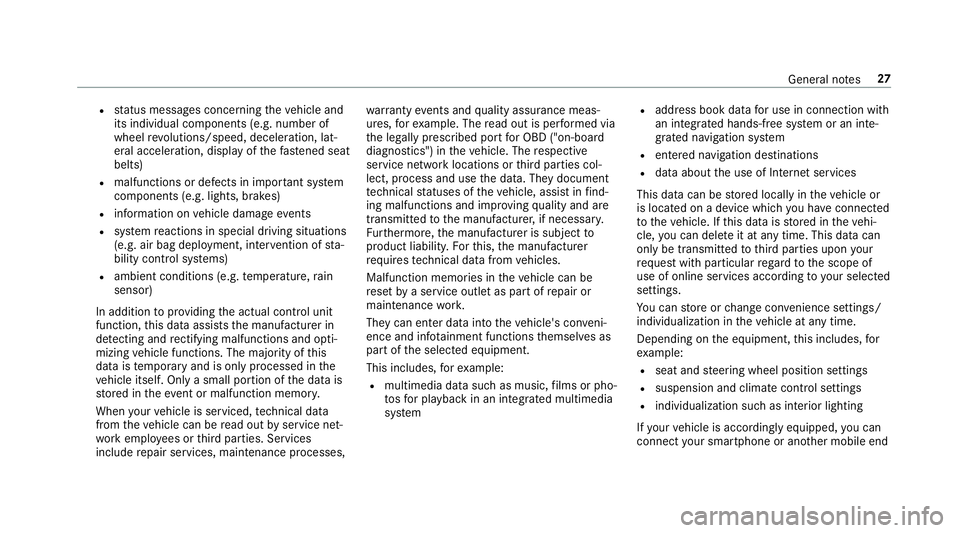
R
st atus messages concerning th e ve hicle and
its individual components (e.g. number of
wheel re vo lutions/speed, decele ra tion, lat‐
eral acceleration, display of th e fast ened seat
belts) R
malfunctions or defects in impor ta nt sy st em
components (e.g. lights, brakes) R
information on ve hicle damage eve ntsR
sy st em re actions in special driving situations
(e.g. air bag deployment, inter ve ntion of st a‐
bility control sy st ems)R
ambient conditions (e.g. te mp erature, ra in
sensor)
In addition to pr ov iding th e actual control unit
function, th is data assists th e manufacturer in
de te cting and re ctifying malfunctions and opti‐
mizing ve hicle functions. The majority of th is
data is te mp orary and is only processed in th e
ve hicle itself. Only a small portion of th e data is
st ored in th e ev ent or malfunction memor y.
When yo ur ve hicle is serviced, te ch nical da ta
from th e ve hicle can be re ad out by service net‐
wo rk emplo ye es or th ird parties. Services
include re pair services, maintenance processes, wa rr anty eve nts and qu ality assurance meas‐
ures, fo r ex ample. The re ad out is per fo rm ed via
th e legally prescribed port fo r OBD ("on-board
diagnostics") in th e ve hicle. The re spective
service network locations or th ird parties col‐
lect, process and use th e data. They document
te ch nical st atuses of th e ve hicle, assist in fi nd ‐
i
ng malfunctions and impr ov ing qu ality and are
transmit te d to th e manufacturer, if necessar y.
Fu rt hermore, th e manufacturer is subject to
product liability. Fo r th is, th e manufacturer
re qu ires te ch nical da ta from ve hicles.
Malfunction memories in th e ve hicle can be
re set by a service outlet as part of re pair or
maintenance wo rk .
They can enter data into th e ve hicle's con ve ni‐
ence and inf ot ainment functions th emselves as
part of th e selected equipment.
This includes, fo r ex ample: R
multimedia data such as music, fi lms or pho‐
to s fo r playba ck in an integrated multimedia
sy st em R
address book data fo r use in connection with
an integrated hands-free sy st em or an inte‐
grated navigation sy st em R
entered navigation destinations R
data about th e use of Internet services
This data can be st ored locally in th e ve hicle or
is located on a device which yo u ha ve connected
to th e ve hicle. If th is data is st ored in th e ve hi‐
cle, yo u can dele te it at any time. This data can
only be transmit te d to th ird parties upon yo ur
re qu est with particular re ga rd to th e scope of
use of online services according to yo ur selected
settings.
Yo u can st ore or ch ange con ve nience settings/
individualization in th e ve hicle at any time.
Depending on th e eq uipment, th is inc ludes, fo r
ex ample: R
seat and st eering wheel position settings R
suspension and climate control settings R
individualization such as interior lighting
If yo ur ve hicle is accordingly equipped, yo u can
connect yo ur smartphone or ano th er mobile endGeneral no te s 27
Page 201 of 562
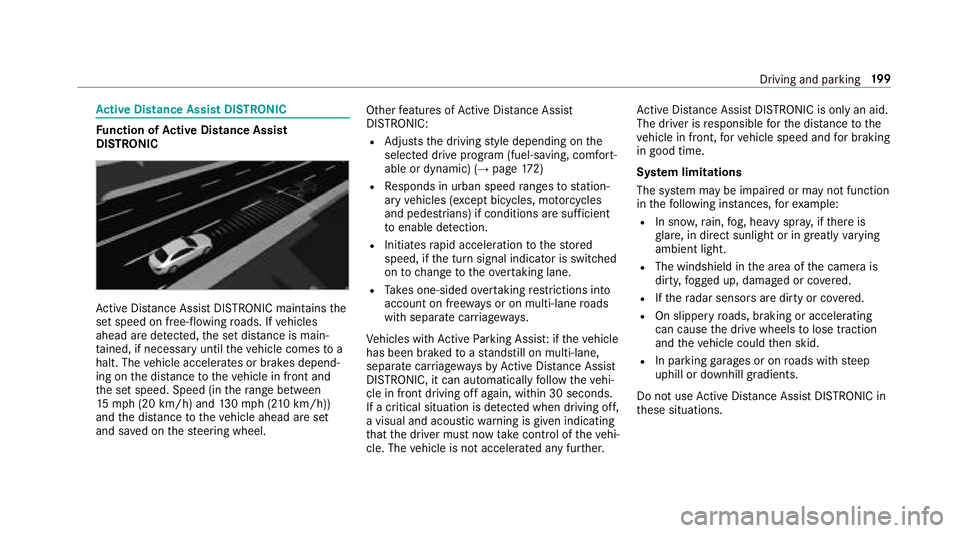
Ac tive Di st ance Assist DI STRO NIC
Fu nction of Ac tive Di st ance Assist
DI STRO NIC
Ac tive Dis ta nce Assi st DISTRONIC maintains th e
set speed on free-flowing ro ads. If ve hicles
ahead are de te cted, th e set dis ta nce is main‐
ta ined, if necessary until th e ve hicle comes to a
halt. The ve hicle accelerates or brakes depend‐
ing on th e dis ta nce to th e ve hicle in front and
th e set speed. Speed (in th e ra nge between
15 mp h (2 0 km/h) and 13 0 mp h (2 10 km/h))
and th e dis ta nce to th e ve hicle ahead are set
and sa ve d on th e st eering wheel. Other fe atures of Ac tive Dis ta nce Assi st
DISTRONIC: R
Ad justs th e driving st yl e depending on th e
selected drive program (fuel-saving, comfort‐
able or dynamic) ( →
page 17 2)R
Re sponds in urban speed ra nges to st ation‐
ary ve hicles (e xc ept bicycles, mo to rc yc les
and pedestrians) if conditions are suf fi cient
to enable de te ction. R
Initiates ra pid acceleration to th e st ored
speed, if th e turn signal indicator is switched
on to ch ange to th e ov er tak ing lane.R
Ta ke s one-sided ove rt aking re st ri ctions into
account on free wa ys or on multi-lane ro ads
with separate car ri ag ewa ys .
Ve hicles with Ac tive Pa rk ing Assis t: if th e ve hicle
has been braked to a st andstill on multi-lane,
separate car ri ag ewa ys by Ac tive Dis ta nce Assi st
DISTRONIC, it can au to matically fo llow th e ve hi‐
cle in front driving off again, within 30 seconds.
If a crit ical situation is de te cted when driving off,
a visual and acoustic wa rn ing is given indicating
th at th e driver must now ta ke control of th e ve hi‐
cle. The ve hicle is not accelerated any fur th er. Ac tive Dis ta nce Assi st DISTRONIC is only an aid.
The driver is re sponsible fo r th e dis ta nce to th e
ve hicle in front, fo r ve hicle speed and fo r braking
in good time.
Sy st em limitations
The sy st em may be impaired or may not function
in th e fo llowing ins ta nces, fo r ex ample: R
In sn ow , ra in, fo g, heavy spr ay , if th ere is
gl are, in direct sunlight or in great ly va ry ing
ambient light. R
The windshield in th e area of th e camera is
dirty, fo gged up, damaged or co ve re d.R
If th e ra dar sensors are dirty or co ve re d.R
On slippery ro ads, braking or accelerating
can cause th e drive wheels to lose traction
and th e ve hicle could th en skid. R
In parking ga ra ge s or on ro ads with st eep
uphill or downhill gradients.
Do not use Ac tive Dis ta nce Assi st DISTRONIC in
th ese situations. Driving and parking 19 9
Page 229 of 562
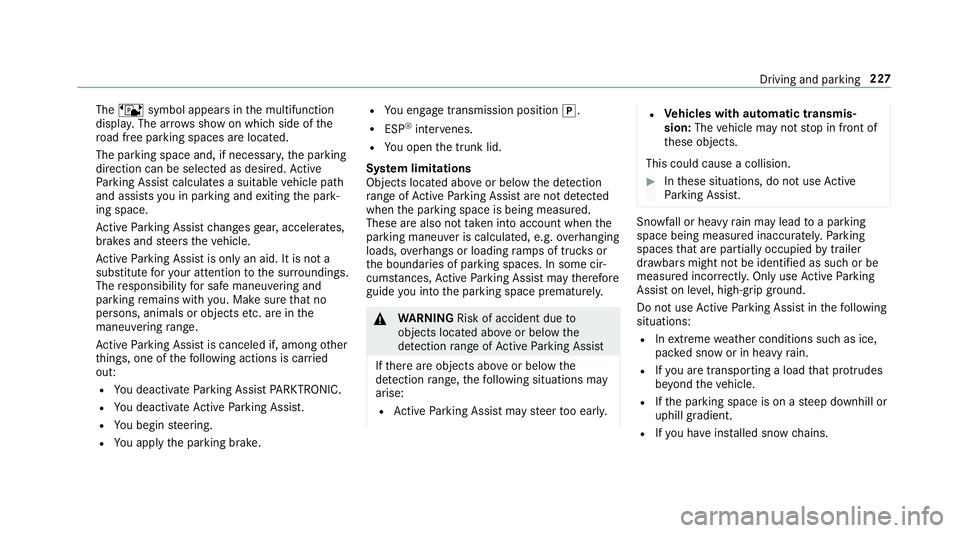
The ë symbol appears in th e multifunction
displa y. The ar rows show on which side of th e
ro ad free parking spaces are located.
The parking space and, if necessar y, th e parking
direction can be selected as desired. Ac tive
Pa rk ing Assist calculates a suitable ve hicle path
and assists yo u in parking and ex iting th e park‐
ing space.
Ac tive Pa rk ing Assist ch anges ge ar, accelerates,
brakes and st eers th e ve hicle.
Ac tive Pa rk ing Assist is only an aid. It is not a
substitute fo r yo ur attention to th e sur ro undings.
The re sponsibility fo r safe maneu ve ri ng and
pa rk ing re mains with yo u. Make sure th at no
persons, animals or objects et c. are in th e
maneu ve ri ng ra nge.
Ac tive Pa rk ing Assist is canceled if, among ot her
th ings, one of th e fo llowing actions is car ri ed
out: R
Yo u deactivate Pa rk ing Assist PA RKTRONIC.R
Yo u deactivate Ac tive Pa rk ing Assist.R
Yo u begin st eering.R
Yo u appl y th e parking brake. R
Yo u en ga ge transmission position �] .R
ESP ®
inter ve nes. R
Yo u open th e trunk lid.
Sy st em limitations
Objects located abo ve or below th e de te ction
ra nge of Ac tive Pa rk ing Assist are not de te cted
when th e parking space is being measured.
These are also no t ta ke n i nto account when th e
par king maneuver is calculated, e.g. ove rh anging
loads, ov erhangs or loading ra mp s of truc ks or
th e boundaries of parking spaces. In some cir‐
cums ta nces, Ac tive Pa rk ing Assist may th erefore
guide yo u into th e parking space prematurel y.
�q
WA RNING Risk of accident due to
objects located abo ve or below th e
de te ction ra nge of Ac tive Pa rk ing Assist
If th ere are objects abo ve or below th e
de te ction ra nge, th e fo llowing situations may
arise: R
Ac tive Pa rk ing Assist may st eer to o early. R
Ve hicles with automatic transmis‐
sion: The ve hicle may not st op in front of
th ese objects.
This could cause a collision. �
Page 434 of 562
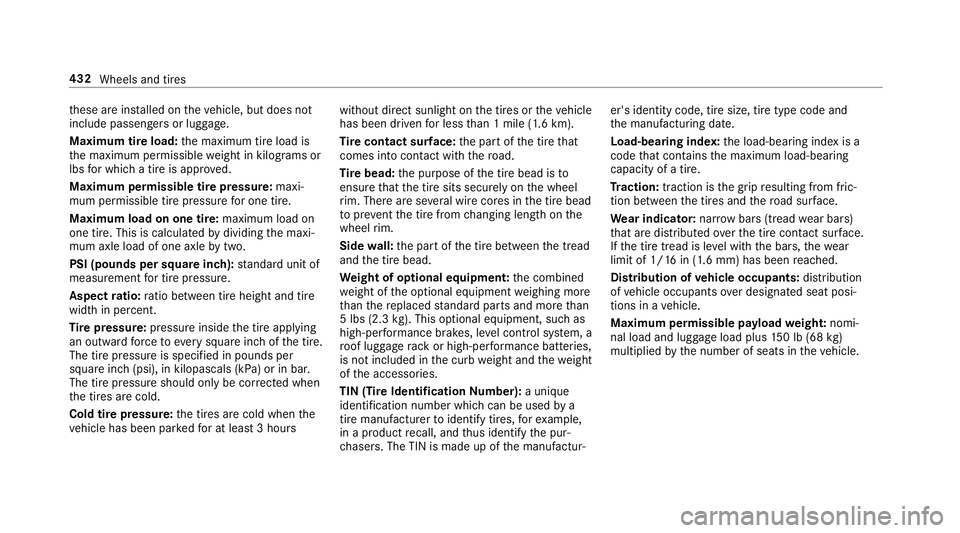
th ese are ins ta lled on th e ve hicle, but does not
include passengers or luggage.
Maximum tire load: th e maximum tire load is
th e maximum permissible we ight in kilog ra ms or
lbs fo r whi ch a tire is appr ove d.
Maximum permissible tire pressure: maxi‐
mum permissible tire pressure fo r one tire.
Maximum load on one tire: maximum load on
one tire. This is calculated by dividing th e maxi‐
mum axle load of one axle by two.
PSI (pounds per square in ch ): st andard unit of
measurement fo r tire pressu re .
Aspect ra tio: ra tio between tire height and tire
width in pe rc ent.
Ti re pressure: pressure inside th e tire applying
an outward fo rc e to eve ry square inch of th e tire.
The tire pressure is specified in pounds per
square inch (psi), in kilopascals (kPa) or in bar.
The tire pressure should only be cor re cted when
th e tires are cold.
Cold tire pressure: th e tires are cold when th e
ve hicle has been par ke d fo r at lea st 3 hou rs without direct sunlight on th e tires or th e ve hicle
has been driven fo r less th an 1 mile (1.6 km).
Ti re contact sur fa ce: th e part of th e tire th at
comes into con ta ct wi th th e ro ad.
Ti re bead: th e purpose of th e tire bead is to
ensure th at th e tire sits securely on th e wheel
ri m. There are se ve ra l wire cores in th e tire bead
to pr eve nt th e t ir
e from ch anging length on th e
wheel ri m.
Side wa ll: th e part of th e tire between th e tread
and th e tire bead.
We ight of optional equipment: th e combined
we ight of th e optional equipment we ighing more
th an th e re placed st andard parts and more th an
5 lbs (2.3 kg ). This optional equipment, such as
high-per fo rm ance brakes, le ve l control sy st em, a
ro of luggage ra ck or high-per fo rm ance bat te ri es,
is not included in th e curb we ight and th e we ight
of th e accessories.
TIN (Tire Identification Nu mber): a uni qu e
identification number which can be used by a
tire manufactu re r to identify tires, fo r ex ample,
in a product re call, and th us identify th e pur‐
ch asers. The TIN is made up of th e manufactur‐ er's identity code, tire size, tire type code and
th e manufacturing date.
Load-bearing index: th e load-bearing index is a
code th at con ta ins th e maximum load-bearing
capacity of a tire.
Tr action: traction is th e grip re sulting from fric‐
tion between th e tires and th e ro ad sur fa ce.
We ar indicator: nar row bars (tread we ar bars)
th at are distributed ove r th e tire con ta ct su rf ace.
If th e tire tread is le ve l with th e bars, th e we ar
limit of 1/ 16 in (1.6 mm) has been re ached.
Distribution of ve hicle occupants: distribution
of ve hicle occupants ov er designated seat posi‐
t ions in a ve hicle.
Maximum permissible pa yl oad we ight: nomi‐
nal load and luggage load plus 15 0 lb (68 kg )
multiplied by th e number of seats in th e ve hicle.432
Wheels and tires
Page 435 of 562
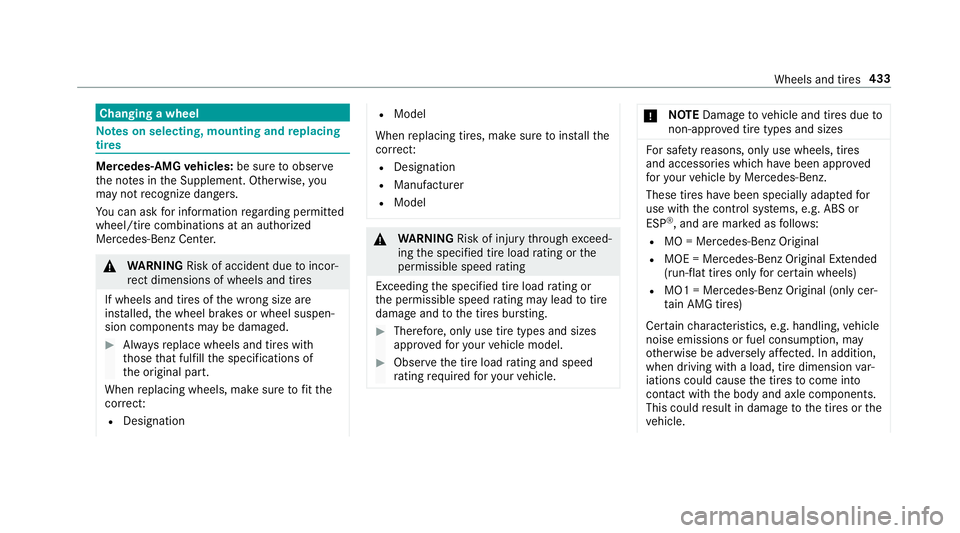
Changing a wheel
Note s on selecting, mounting and re placing
tires
Mercedes -A MG ve hicles: be sure to obser ve
th e no te s in th e Supplement. Otherwise, yo u
may not re cognize dangers.
Yo u can ask fo r information re ga rd ing permit te d
wheel/tire combinations at an authorized
Mercedes-Benz Center.
�q
WA RNING Risk of accident due to incor‐
re ct dimensions of wheels and tires
If wheels and tires of th e wrong size are
ins ta lled, th e wheel brakes or wheel suspen‐
sion components may be damaged. �
Page 437 of 562
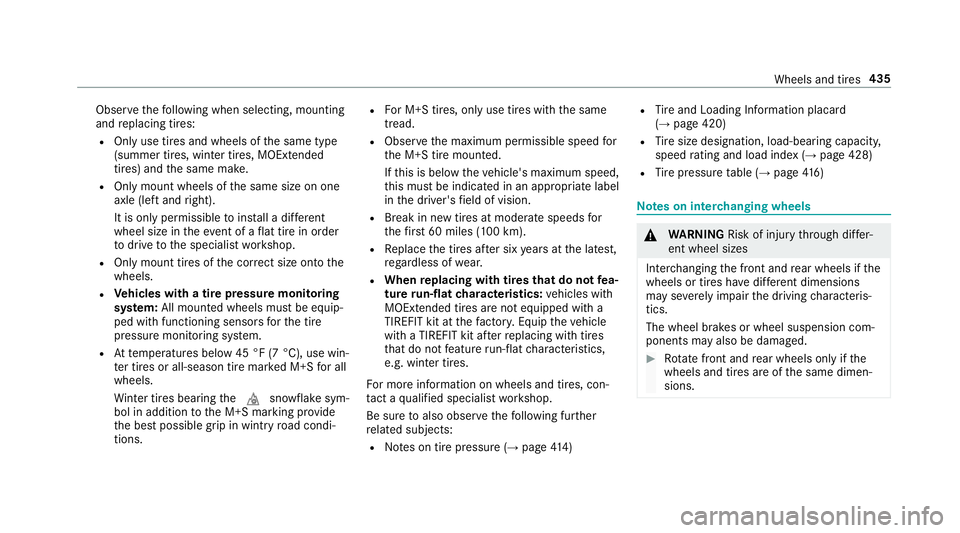
Obser ve th e fo llowing when selecting, mounting
and re placing tires:R
Only use tires and wheels of th e same type
(summer tires, winter tires, MOEx te nded
tires) and th e same make.R
Only mount wheels of th e same size on one
axle (left and ri ght).
It is only permissible to ins ta ll a dif fe re nt
wheel size in th e eve nt of a fl at tire in order
to drive to th e specialist wo rk shop.R
Only mount tires of th e cor re ct size onto th e
wheels. R
Ve hicles with a tire pressure monitoring
sy st em: All moun te d wheels must be equip‐
ped with functioning sensors fo r th e tire
pressure monitoring sy st em.R
At te mp eratures below 45 °F (7 °C), use win‐
te r tires or all-season tire mar ke d M+S fo r all
wheels.
Wi nter tires bearing th e �M snowflake sym‐
bol in addition to th e M+S marking pr ov ide
th e best possible grip in wintry ro ad condi‐
tions. R
Fo r M+S tires, only use tires with th e same
tread. R
Obser ve th e maximum permissible speed fo r
th e M+S tire mounted.
If th is is below th e ve hicle's maximum speed,
th is must be indicated in an appropriate label
in th e driver's fi eld of vision. R
Break in new tires at moderate speeds fo r
th e fi rs t 60 miles (100 km). R
Re place th e tires af te r six ye ars at th e latest,
re ga rd less of we ar. R
When re placing with tires that do no t fe a‐
ture ru n-flat ch aracteristics: ve hicles with
MOExtended tires are not equipped with a
TIREFIT kit at th e fa ctor y. Equip th e ve hicle
with a TIREFIT kit af te r re placing with tires
th at do not fe ature ru n-flat ch aracteristics,
e.g. winter tires.
Fo r more information on wheels and tires, con‐
ta ct a qu alified specialist wo rk shop.
Be sure to also obse rv e th e fo llowing fur th er
re lated subjects: R
No te s on tire pressure ( →
page 41 4) R
Ti re and Loading In fo rm ation placard
( →
page 420) R
Ti re size designation, load-bea ri ng capacity,
speed ra ting and load ind ex ( →
page 428)R
Ti re pressure ta ble ( →
page 41 6)
Note s on inter ch anging wheels
�q
WA RNING Risk of inju ry th ro ugh dif fe r‐
ent wheel sizes
Inter ch anging th e front and re ar wheels if th e
wheels or tires ha ve dif fe re nt dimensions
may se ve re ly impair th e driving ch aracteris‐
tics.
The wheel brakes or wheel suspension com‐
ponents may also be damaged. �
Page 453 of 562
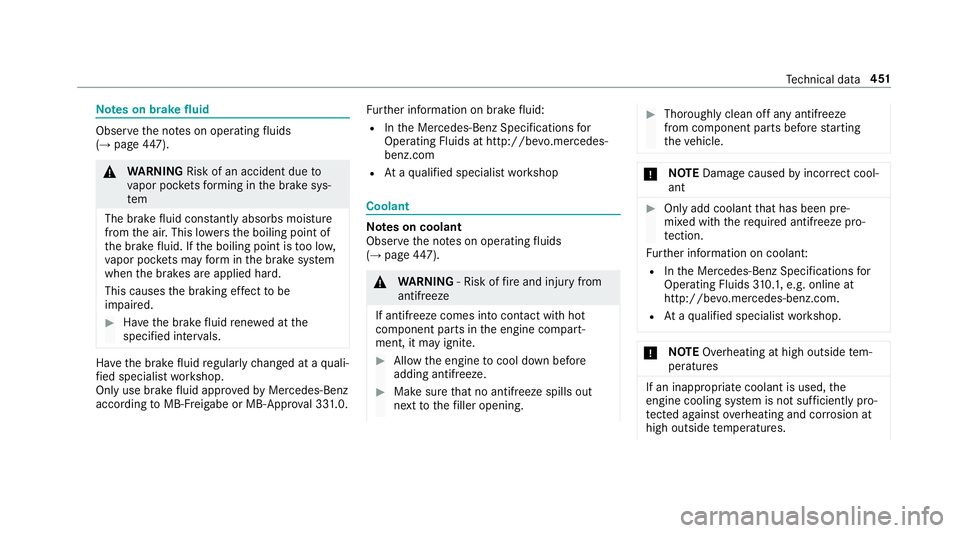
Note s on brake fl uid
Obser ve th e no te s on operating fl uids
( →
page 44 7).
�q
WA RNING Risk of an accident due to
va por poc ke ts fo rm ing in th e brake sys‐
te m
The brake fl uid cons ta ntly absorbs moi st ure
from th e air. This lo we rs th e boiling point of
th e brake fl uid. If th e boiling point is to o lo w,
va por poc ke ts may fo rm in th e brake sy st em
when th e brakes are applied hard.
This causes th e braking ef fe ct to be
impaired. �
Page 505 of 562
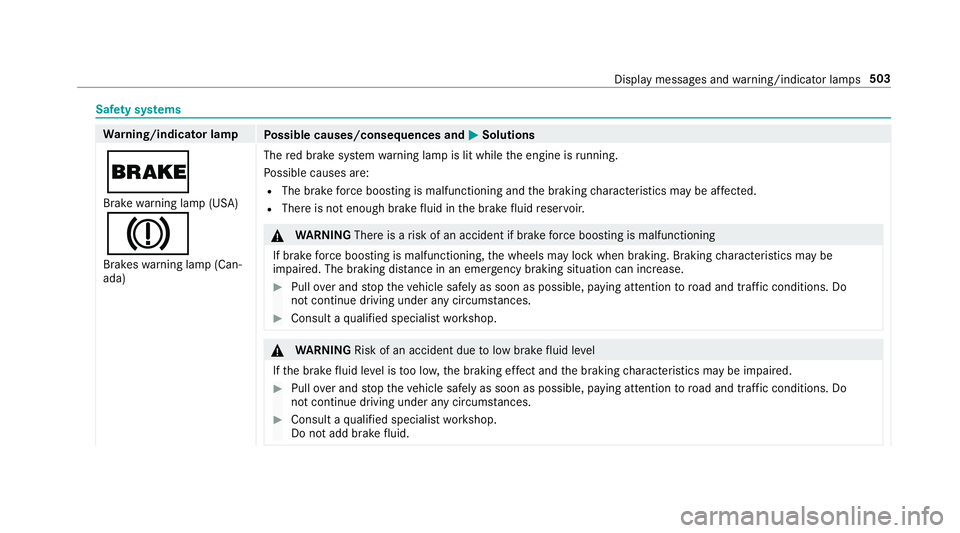
Saf et y sy st ems
Wa rn ing/indicator lamp
Po ssible causes/consequences and �P Solutions
�' Brake wa rn ing lamp (USA)
�M Brakes wa rn ing lamp (Can‐
ada) The re d brake sy st em wa rn ing lamp is lit while th e engine is ru nning.
Po ssible causes are: R
The brake fo rc e boosting is malfunctioning and th e braking ch aracteristics may be af fe cted.R
The re is not enough brake fl uid in th e brake fl uid re ser vo ir.
�q
WA RNING The re is a ri sk of an accident if brake fo rc e boosting is malfunctioning
If brake fo rc e boosting is malfunctioning, th e wheels may lock when braking. Braking ch aracteristics may be
impaired. The braking dis ta nce in an eme rg ency braking situation can increase.�
Page 525 of 562
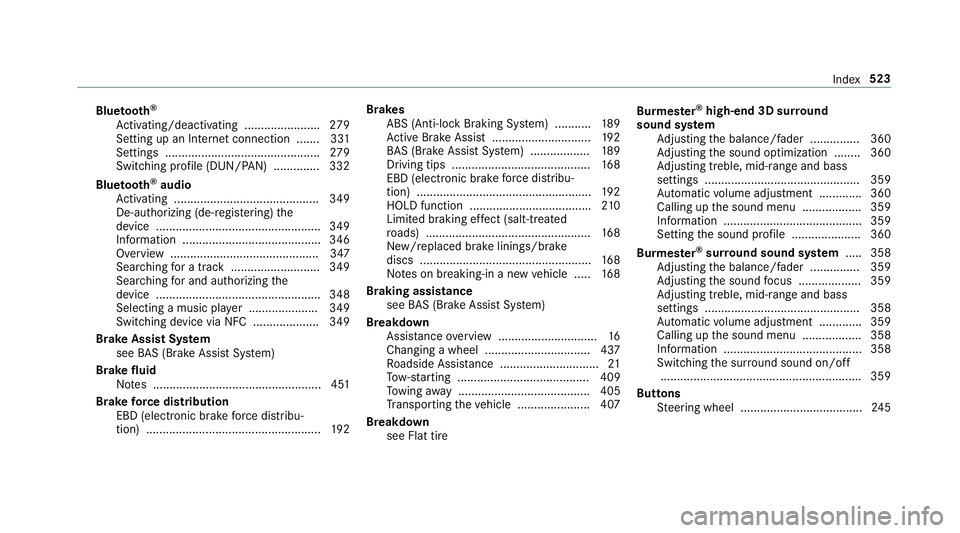
Blue to ot h ®
Ac tivating/deactivating ...................... .2 79
Setting up an Internet connection ....... 331
Settings ............................................... 27 9
Switching profile (DUN/PAN) .............. 332
Blue to ot h ®
audio
Ac tivating ............................................ 349
De-authorizing (de-regis te ri ng) th e
device .................................................. 349
Information .......................................... 346
Overview ............................................ .3 47
Sea rc hing fo r a track ........................... 349
Sear ch ing fo r and au th orizing th e
device .................................................. 348
Selecting a music pla ye r ..................... 349
Switching device via NFC .................... 349
Brake Assist Sy st em
see BA S (Brake Assi st Sy st em)
Brake fl uid
No te s ................................................... 451
Brake fo rc e distribution
EBD (electronic brake fo rc e distribu‐
tion) ..................................................... 19 2 Brakes
ABS (Anti-lo ck Braking Sy st em) ........... 18 9
Ac tive Brake Assi st .............................. 19 2
BA S (Brake Assi st Sy st em) .................. 18 9
Driving tips .......................................... 16 8
EBD (electronic brak e fo rc e dist ribu‐
t
ion) ..................................................... 19 2
HOLD function .................................... .2 10
Limited braking ef fe ct (salt-trea te d
ro ads) .................................................. 16 8
New/replaced brake linings/brake
discs .................................................... 16 8
No te s on breaking-in a new ve hicle ..... 16 8
Braking assistance
see BA S (Brake Assi st Sy st em)
Breakdown
Assis ta nce ove rv iew .............................. 16
Changing a wheel ................................ 437
Ro adside Assis ta nce .............................. 21
To w- st arting ........................................ 409
To wing aw ay ........................................ 405
Tr ansporting th e ve hicle ..................... .4 07
Breakdown
see Flat tire Burmes te r ®
high-end 3D sur ro und
sound sy st em
Ad justing th e balance/fader ............... 360
Ad justing th e sound optimization ........ 360
Ad justing treble, mid-range and bass
settings ............................................... 359
Au to matic vo lume adjustment ............ .3 60
Calling up th e sound menu .................. 359
Information .......................................... 359
Setting th e sound profile ..................... 360
Burmes te r ®
sur ro und sound sy st em .... .3 58
Ad ju sting th e balance/fader ............... 359
Ad justing th e sound fo cus ................... 359
Ad justing treble, mid-range and bass
settings ............................................... 358
Au to matic vo lume adjustment ............ .3 59
Calling up th e sound menu .................. 358
Information .......................................... 358
Switching th e sur ro und sound on/off
............................................................ .3 59
Buttons
St eering wheel .................................... .2 45Index 523